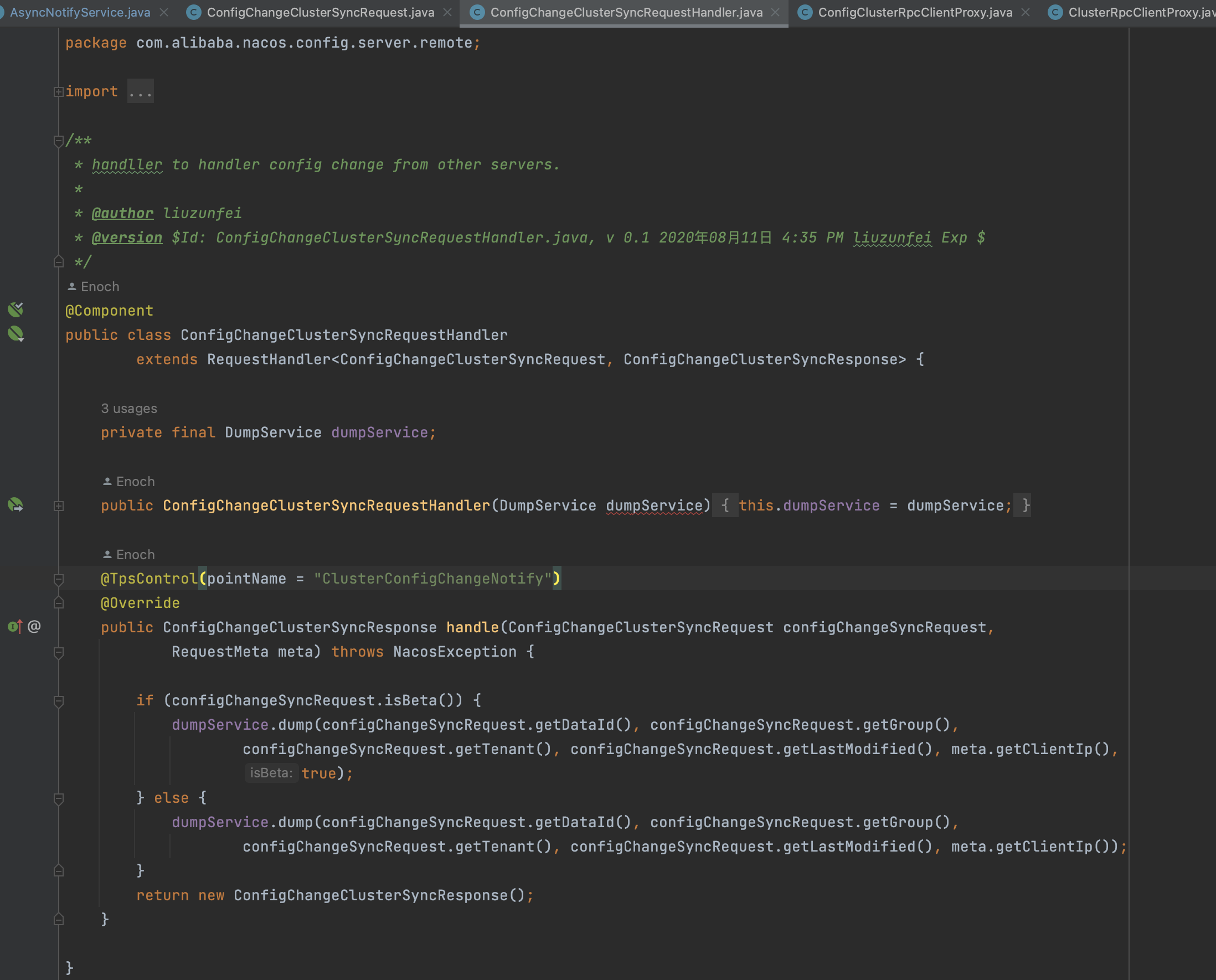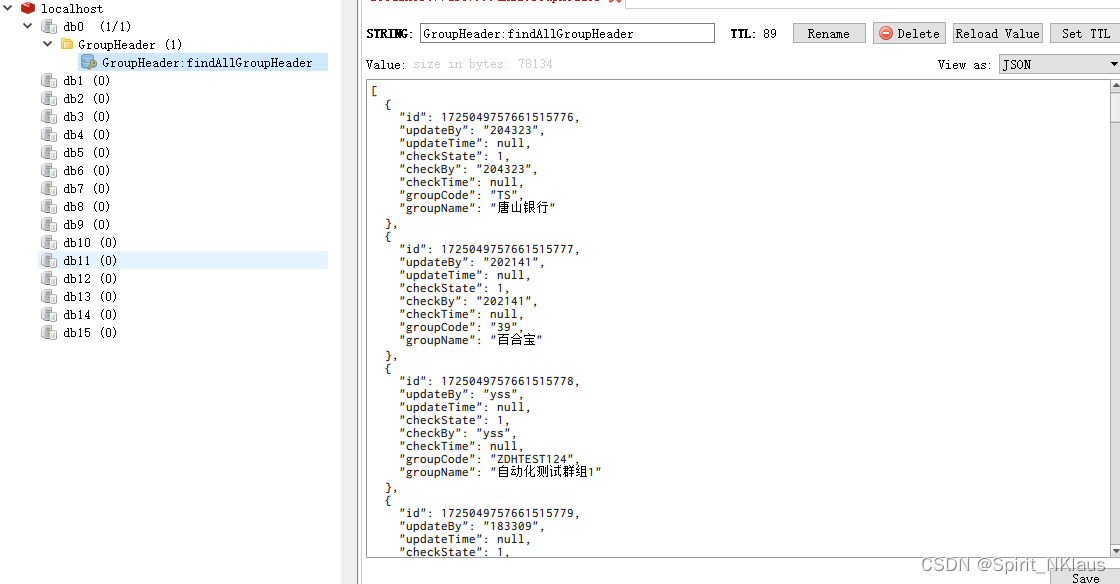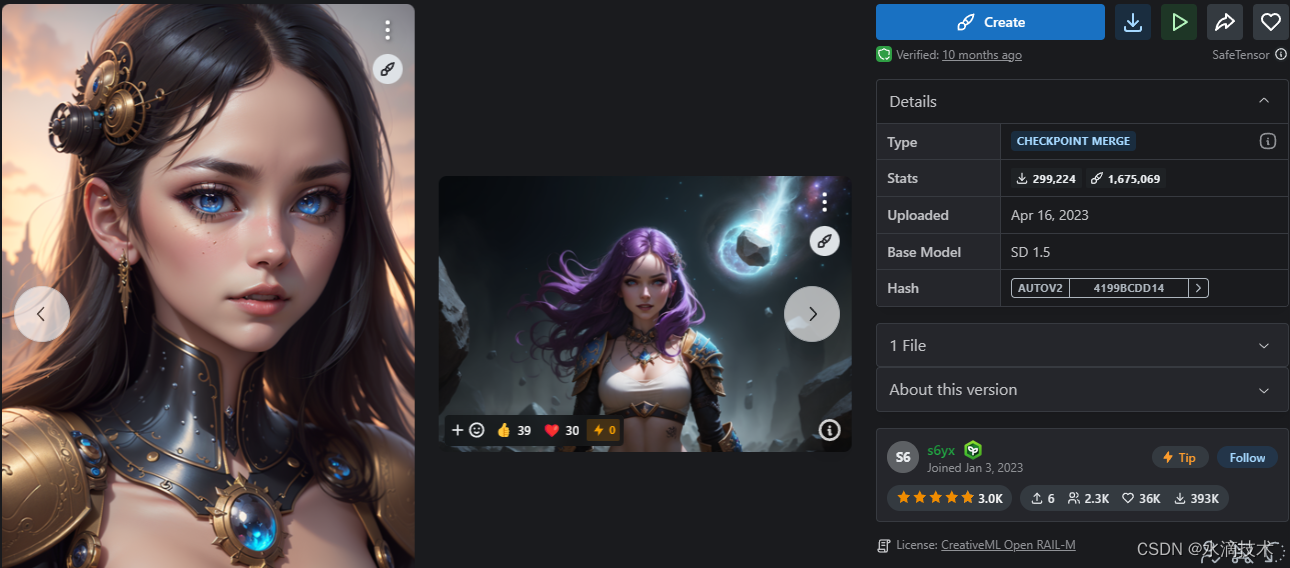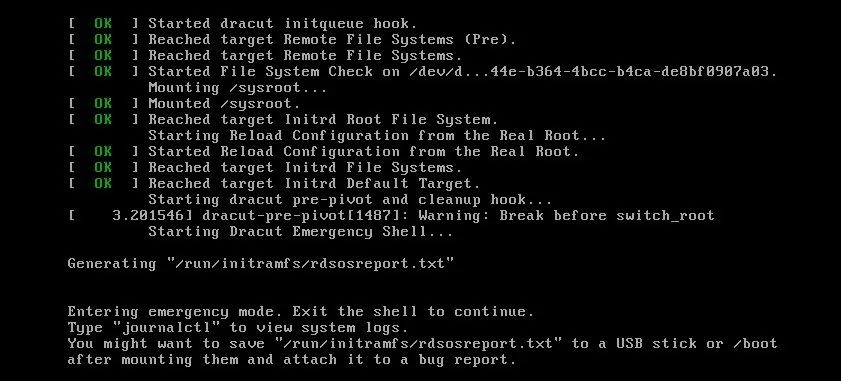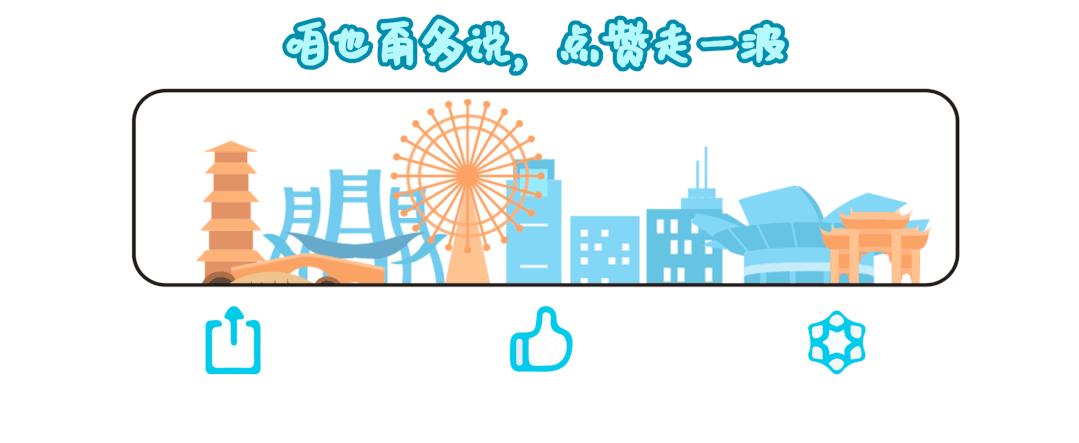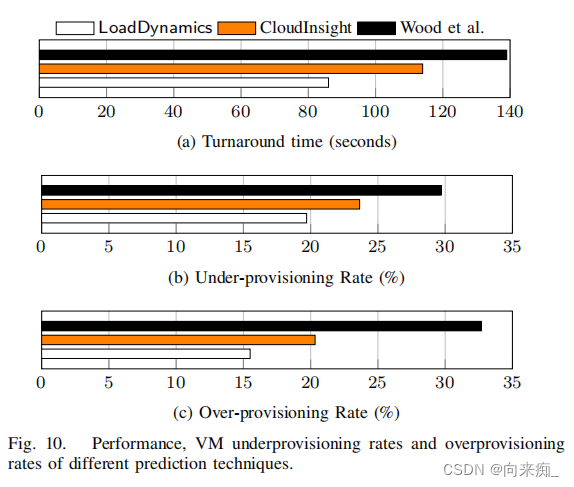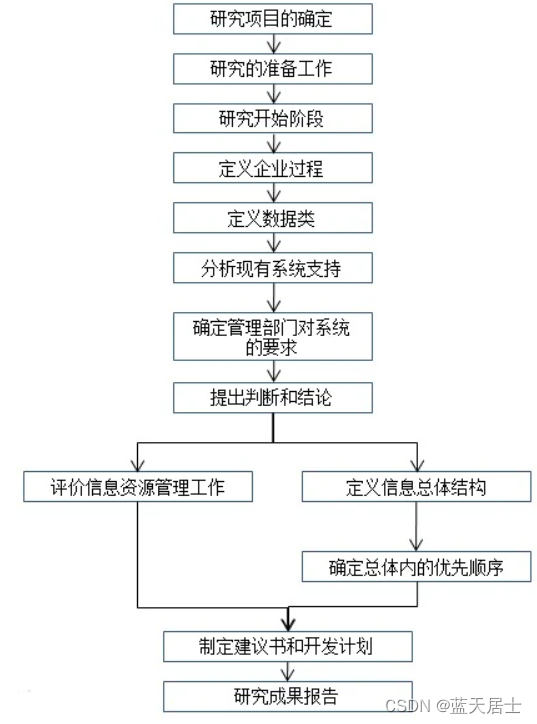入口
getServerConfig对应:ConfigQueryRequestHandler�
getBatchServiceConfig对应:ConfigChangeBatchListenResponse�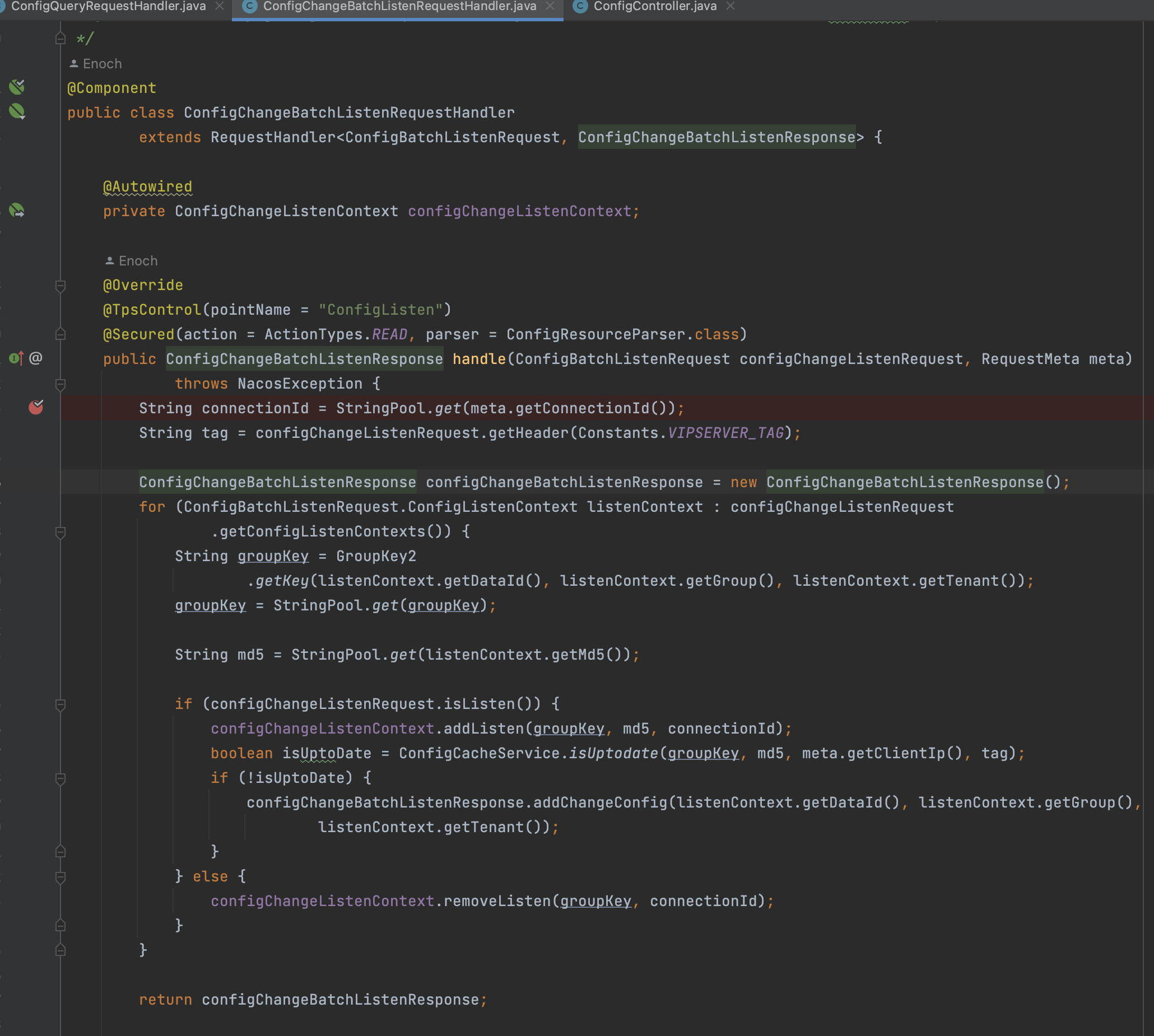
admin对应:ConfigController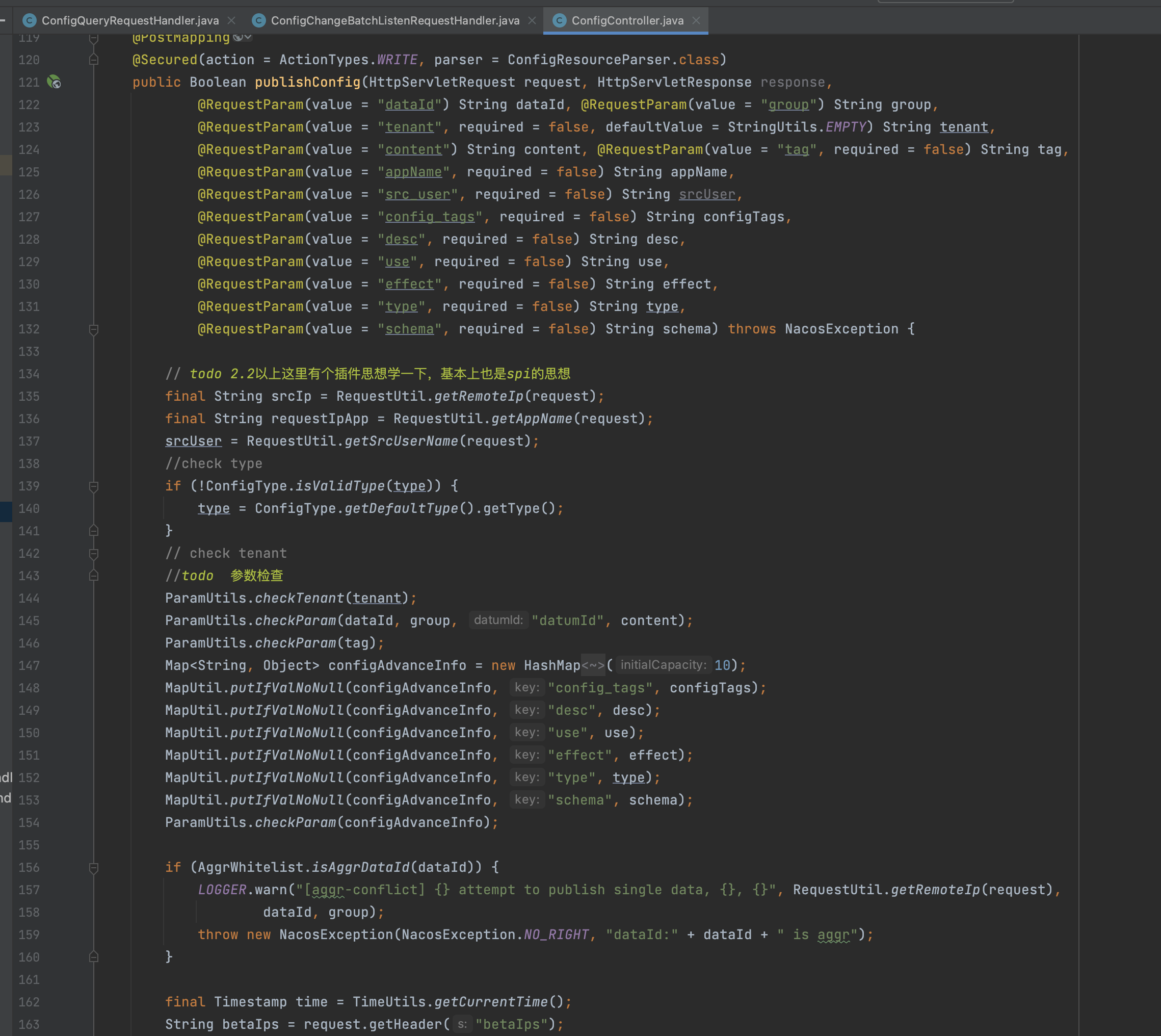
我们重点就要2个,一个是服务端如何完成客户端获取配置请求,一个是服务端更新配置,客户端如何更新, 也就是说ConfigQueryReustHandler和ConfigController
ConfigQueryRequestHandler
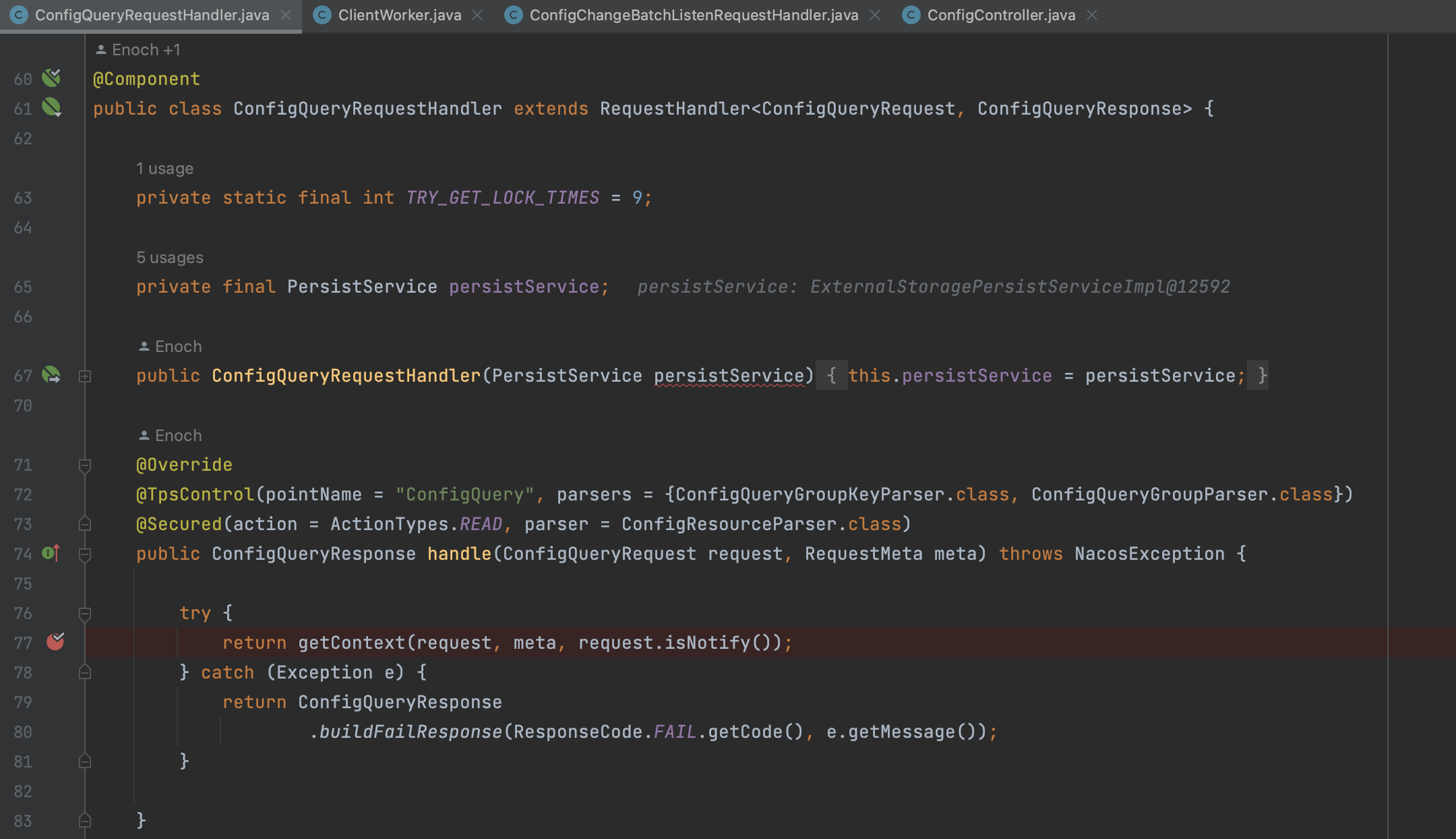
ConfigQueryRequestHandler.getContext
private ConfigQueryResponse getContext(ConfigQueryRequest configQueryRequest, RequestMeta meta, boolean notify)
throws UnsupportedEncodingException {
// todo
String dataId = configQueryRequest.getDataId();
String group = configQueryRequest.getGroup();
String tenant = configQueryRequest.getTenant();
String clientIp = meta.getClientIp();
String tag = configQueryRequest.getTag();
ConfigQueryResponse response = new ConfigQueryResponse();
final String groupKey = GroupKey2
.getKey(configQueryRequest.getDataId(), configQueryRequest.getGroup(), configQueryRequest.getTenant());
String autoTag = configQueryRequest.getHeader(com.alibaba.nacos.api.common.Constants.VIPSERVER_TAG);
String requestIpApp = meta.getLabels().get(CLIENT_APPNAME_HEADER);
int lockResult = tryConfigReadLock(groupKey);
boolean isBeta = false;
boolean isSli = false;
if (lockResult > 0) {
//FileInputStream fis = null;
try {
String md5 = Constants.NULL;
long lastModified = 0L;
// todo 从缓存中获取
CacheItem cacheItem = ConfigCacheService.getContentCache(groupKey);
if (cacheItem != null) {
if (cacheItem.isBeta()) {
if (cacheItem.getIps4Beta().contains(clientIp)) {
isBeta = true;
}
}
String configType = cacheItem.getType();
response.setContentType((null != configType) ? configType : "text");
}
File file = null;
ConfigInfoBase configInfoBase = null;
PrintWriter out = null;
if (isBeta) {
md5 = cacheItem.getMd54Beta();
lastModified = cacheItem.getLastModifiedTs4Beta();
if (PropertyUtil.isDirectRead()) {
configInfoBase = persistService.findConfigInfo4Beta(dataId, group, tenant);
} else {
file = DiskUtil.targetBetaFile(dataId, group, tenant);
}
response.setBeta(true);
} else {
if (StringUtils.isBlank(tag)) {
if (isUseTag(cacheItem, autoTag)) {
if (cacheItem != null) {
if (cacheItem.tagMd5 != null) {
md5 = cacheItem.tagMd5.get(autoTag);
}
if (cacheItem.tagLastModifiedTs != null) {
lastModified = cacheItem.tagLastModifiedTs.get(autoTag);
}
}
if (PropertyUtil.isDirectRead()) {
configInfoBase = persistService.findConfigInfo4Tag(dataId, group, tenant, autoTag);
} else {
file = DiskUtil.targetTagFile(dataId, group, tenant, autoTag);
}
response.setTag(URLEncoder.encode(autoTag, Constants.ENCODE));
} else {
md5 = cacheItem.getMd5();
lastModified = cacheItem.getLastModifiedTs();
// todo 是否是数据读
if (PropertyUtil.isDirectRead()) {
configInfoBase = persistService.findConfigInfo(dataId, group, tenant);
} else {
file = DiskUtil.targetFile(dataId, group, tenant);
}
if (configInfoBase == null && fileNotExist(file)) {
// FIXME CacheItem
// No longer exists. It is impossible to simply calculate the push delayed. Here, simply record it as - 1.
ConfigTraceService.logPullEvent(dataId, group, tenant, requestIpApp, -1,
ConfigTraceService.PULL_EVENT_NOTFOUND, -1, clientIp, false);
// pullLog.info("[client-get] clientIp={}, {},
// no data",
// new Object[]{clientIp, groupKey});
response.setErrorInfo(ConfigQueryResponse.CONFIG_NOT_FOUND, "config data not exist");
return response;
}
}
} else {
if (cacheItem != null) {
if (cacheItem.tagMd5 != null) {
md5 = cacheItem.tagMd5.get(tag);
}
if (cacheItem.tagLastModifiedTs != null) {
Long lm = cacheItem.tagLastModifiedTs.get(tag);
if (lm != null) {
lastModified = lm;
}
}
}
if (PropertyUtil.isDirectRead()) {
configInfoBase = persistService.findConfigInfo4Tag(dataId, group, tenant, tag);
} else {
file = DiskUtil.targetTagFile(dataId, group, tenant, tag);
}
if (configInfoBase == null && fileNotExist(file)) {
// FIXME CacheItem
// No longer exists. It is impossible to simply calculate the push delayed. Here, simply record it as - 1.
ConfigTraceService.logPullEvent(dataId, group, tenant, requestIpApp, -1,
ConfigTraceService.PULL_EVENT_NOTFOUND, -1, clientIp, false);
// pullLog.info("[client-get] clientIp={}, {},
// no data",
// new Object[]{clientIp, groupKey});
response.setErrorInfo(ConfigQueryResponse.CONFIG_NOT_FOUND, "config data not exist");
return response;
}
}
}
response.setMd5(md5);
if (PropertyUtil.isDirectRead()) {
response.setLastModified(lastModified);
response.setContent(configInfoBase.getContent());
response.setResultCode(ResponseCode.SUCCESS.getCode());
} else {
//read from file
String content = null;
try {
content = readFileContent(file);
response.setContent(content);
response.setLastModified(lastModified);
response.setResultCode(ResponseCode.SUCCESS.getCode());
} catch (IOException e) {
response.setErrorInfo(ResponseCode.FAIL.getCode(), e.getMessage());
return response;
}
}
LogUtil.PULL_CHECK_LOG.warn("{}|{}|{}|{}", groupKey, clientIp, md5, TimeUtils.getCurrentTimeStr());
final long delayed = System.currentTimeMillis() - lastModified;
// TODO distinguish pull-get && push-get
/*
Otherwise, delayed cannot be used as the basis of push delay directly,
because the delayed value of active get requests is very large.
*/
ConfigTraceService.logPullEvent(dataId, group, tenant, requestIpApp, lastModified,
ConfigTraceService.PULL_EVENT_OK, notify ? delayed : -1, clientIp, notify);
} finally {
releaseConfigReadLock(groupKey);
}
} else if (lockResult == 0) {
// FIXME CacheItem No longer exists. It is impossible to simply calculate the push delayed. Here, simply record it as - 1.
ConfigTraceService
.logPullEvent(dataId, group, tenant, requestIpApp, -1, ConfigTraceService.PULL_EVENT_NOTFOUND, -1,
clientIp, notify);
response.setErrorInfo(ConfigQueryResponse.CONFIG_NOT_FOUND, "config data not exist");
} else {
PULL_LOG.info("[client-get] clientIp={}, {}, get data during dump", clientIp, groupKey);
response.setErrorInfo(ConfigQueryResponse.CONFIG_QUERY_CONFLICT,
"requested file is being modified, please try later.");
}
return response;
}
这一段代码很长,感觉写的也不是很好,很冗长,总结一下:
- 通过groupKey从ConfigCacheService.getContentCache(groupKey)获取cacheItem, 这里的cacheItem要等到pushConfig在看一下,具体用来做什么,只是做一些数据的暂存吗?
- 然后看了一下是否从数据读,如果是就从数据库读出配置,如果不是,就从文件中读取
�
PropertyUtil.isDirectRead
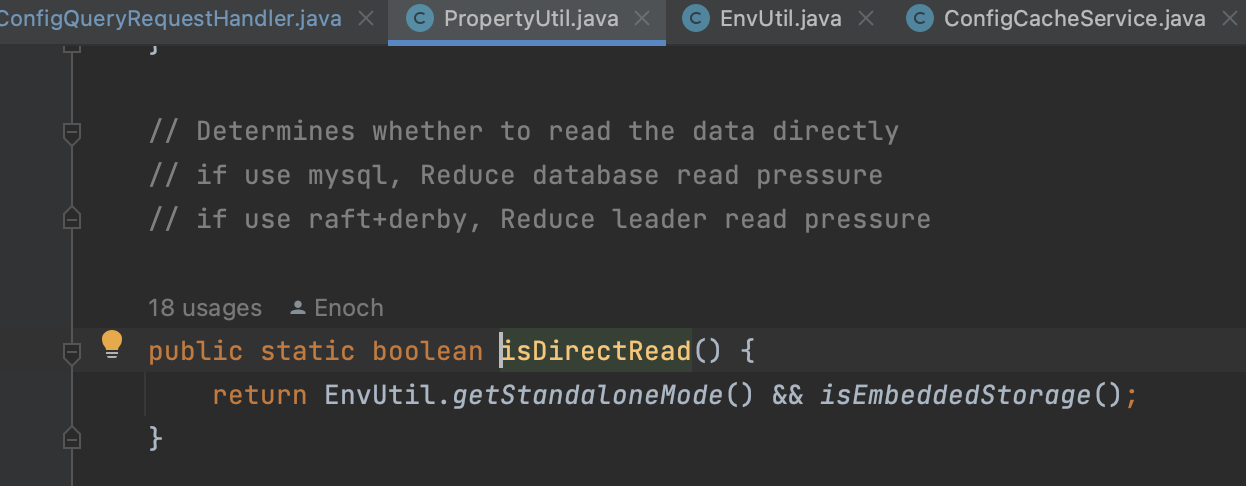
persistService.findConfigInfo

ConfigController
ConfigController.pushConfig
@PostMapping
@Secured(action = ActionTypes.WRITE, parser = ConfigResourceParser.class)
public Boolean publishConfig(HttpServletRequest request, HttpServletResponse response,
@RequestParam(value = "dataId") String dataId, @RequestParam(value = "group") String group,
@RequestParam(value = "tenant", required = false, defaultValue = StringUtils.EMPTY) String tenant,
@RequestParam(value = "content") String content, @RequestParam(value = "tag", required = false) String tag,
@RequestParam(value = "appName", required = false) String appName,
@RequestParam(value = "src_user", required = false) String srcUser,
@RequestParam(value = "config_tags", required = false) String configTags,
@RequestParam(value = "desc", required = false) String desc,
@RequestParam(value = "use", required = false) String use,
@RequestParam(value = "effect", required = false) String effect,
@RequestParam(value = "type", required = false) String type,
@RequestParam(value = "schema", required = false) String schema) throws NacosException {
// todo 2.2以上这里有个插件思想学一下,基本上也是spi的思想
final String srcIp = RequestUtil.getRemoteIp(request);
final String requestIpApp = RequestUtil.getAppName(request);
srcUser = RequestUtil.getSrcUserName(request);
//check type
if (!ConfigType.isValidType(type)) {
type = ConfigType.getDefaultType().getType();
}
// check tenant
//todo 参数检查
ParamUtils.checkTenant(tenant);
ParamUtils.checkParam(dataId, group, "datumId", content);
ParamUtils.checkParam(tag);
Map<String, Object> configAdvanceInfo = new HashMap<String, Object>(10);
MapUtil.putIfValNoNull(configAdvanceInfo, "config_tags", configTags);
MapUtil.putIfValNoNull(configAdvanceInfo, "desc", desc);
MapUtil.putIfValNoNull(configAdvanceInfo, "use", use);
MapUtil.putIfValNoNull(configAdvanceInfo, "effect", effect);
MapUtil.putIfValNoNull(configAdvanceInfo, "type", type);
MapUtil.putIfValNoNull(configAdvanceInfo, "schema", schema);
ParamUtils.checkParam(configAdvanceInfo);
if (AggrWhitelist.isAggrDataId(dataId)) {
LOGGER.warn("[aggr-conflict] {} attempt to publish single data, {}, {}", RequestUtil.getRemoteIp(request),
dataId, group);
throw new NacosException(NacosException.NO_RIGHT, "dataId:" + dataId + " is aggr");
}
final Timestamp time = TimeUtils.getCurrentTime();
String betaIps = request.getHeader("betaIps");
// todo // 构造配置信息
ConfigInfo configInfo = new ConfigInfo(dataId, group, tenant, appName, content);
configInfo.setType(type);
if (StringUtils.isBlank(betaIps)) {
if (StringUtils.isBlank(tag)) {
persistService.insertOrUpdate(srcIp, srcUser, configInfo, time, configAdvanceInfo, false);
// todo 由AsyncNotifyService处理
ConfigChangePublisher
.notifyConfigChange(new ConfigDataChangeEvent(false, dataId, group, tenant, time.getTime()));
} else {
persistService.insertOrUpdateTag(configInfo, tag, srcIp, srcUser, time, false);
// todo 由AsyncNotifyService处理
ConfigChangePublisher.notifyConfigChange(
new ConfigDataChangeEvent(false, dataId, group, tenant, tag, time.getTime()));
}
} else {
// beta publish
persistService.insertOrUpdateBeta(configInfo, betaIps, srcIp, srcUser, time, false);
ConfigChangePublisher
.notifyConfigChange(new ConfigDataChangeEvent(true, dataId, group, tenant, time.getTime()));
}
ConfigTraceService
.logPersistenceEvent(dataId, group, tenant, requestIpApp, time.getTime(), InetUtils.getSelfIP(),
ConfigTraceService.PERSISTENCE_EVENT_PUB, content);
return true;
}
一共做了这么几件事:
- persistsService.insertOrUpdate
- 发送ConfigDataChangeEvent,这个事件最终由AsyncNotifyService执行到
AsyncNotifyService.onEvent
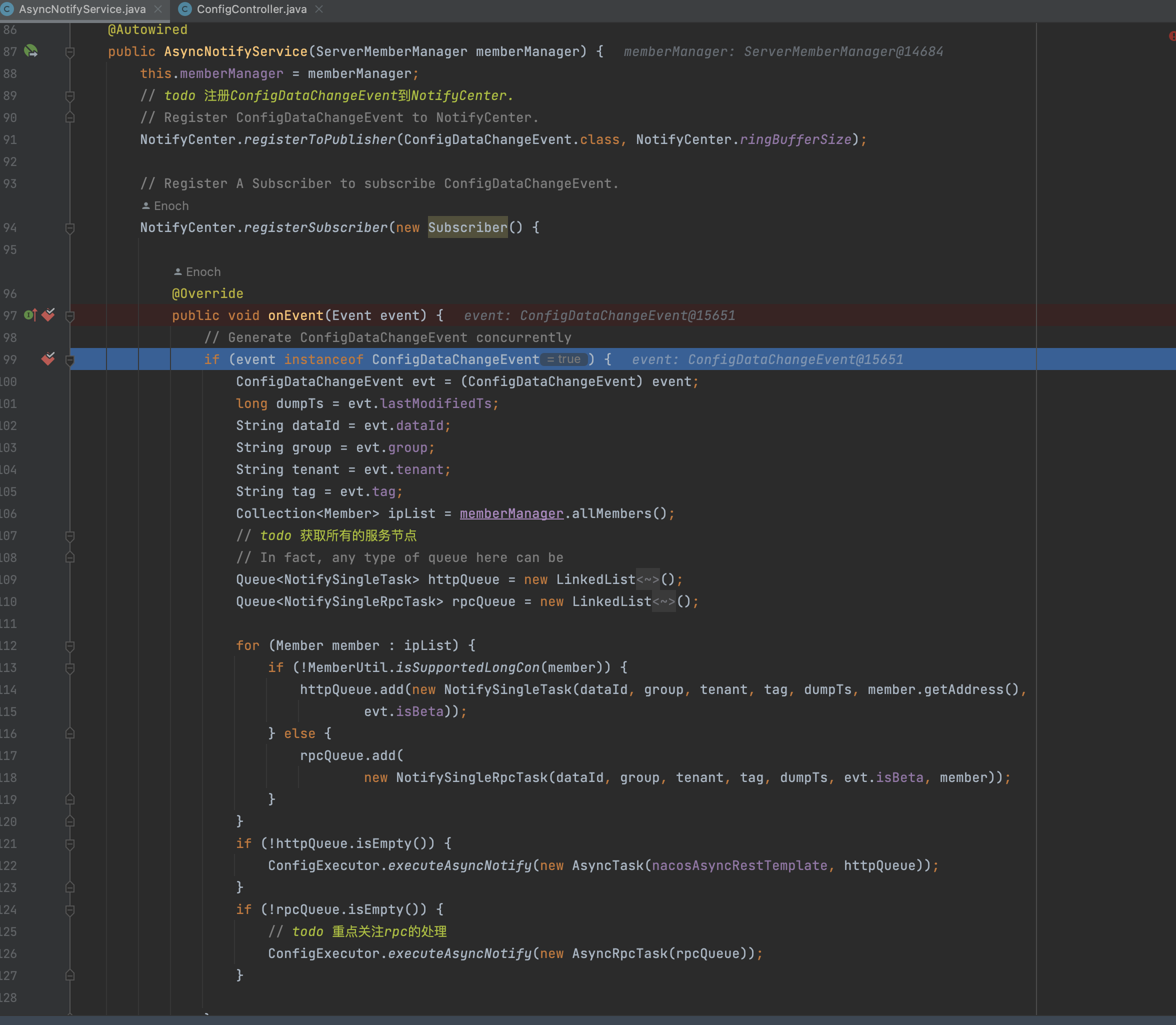
这里做了这么几件事:
- memberManager.allMembers():获取到所有的服务节点,我这里因为是单机启动的,所以就一台

- 看对应的服务是否支持长链接,如果支持就放到rpcQueue中,如果不支持,就放到httpQueue,基本到这里就知道后面要做什么,肯定又是什么线程要消费这里的queue
- 将rpcQueue放到AsyncRpcTask里面去,然后用一个异步线程池调用它
其中ConfigExecutor:

不往下追了,就是一个简单的定时调度线程池,反正最终也是调度到AsyncRpcTask的run方法,这个更重要
其中AsyncRpcTask: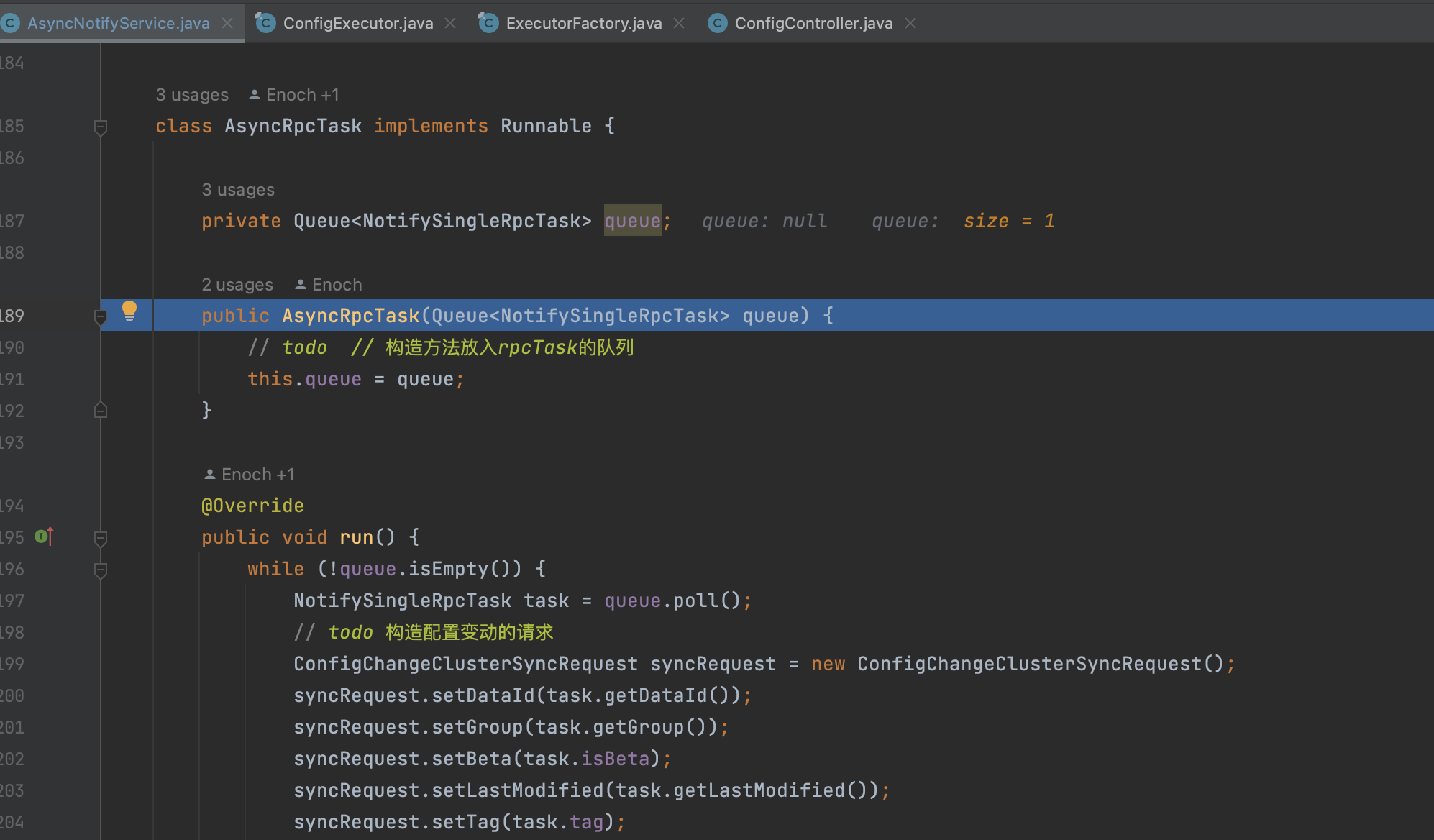
每一个AsyncRpcTask里面有一个队列,这个队列里面存放的是NotifySingleRpcTask:就是rpc通知任务
AsyncRpcTask.run
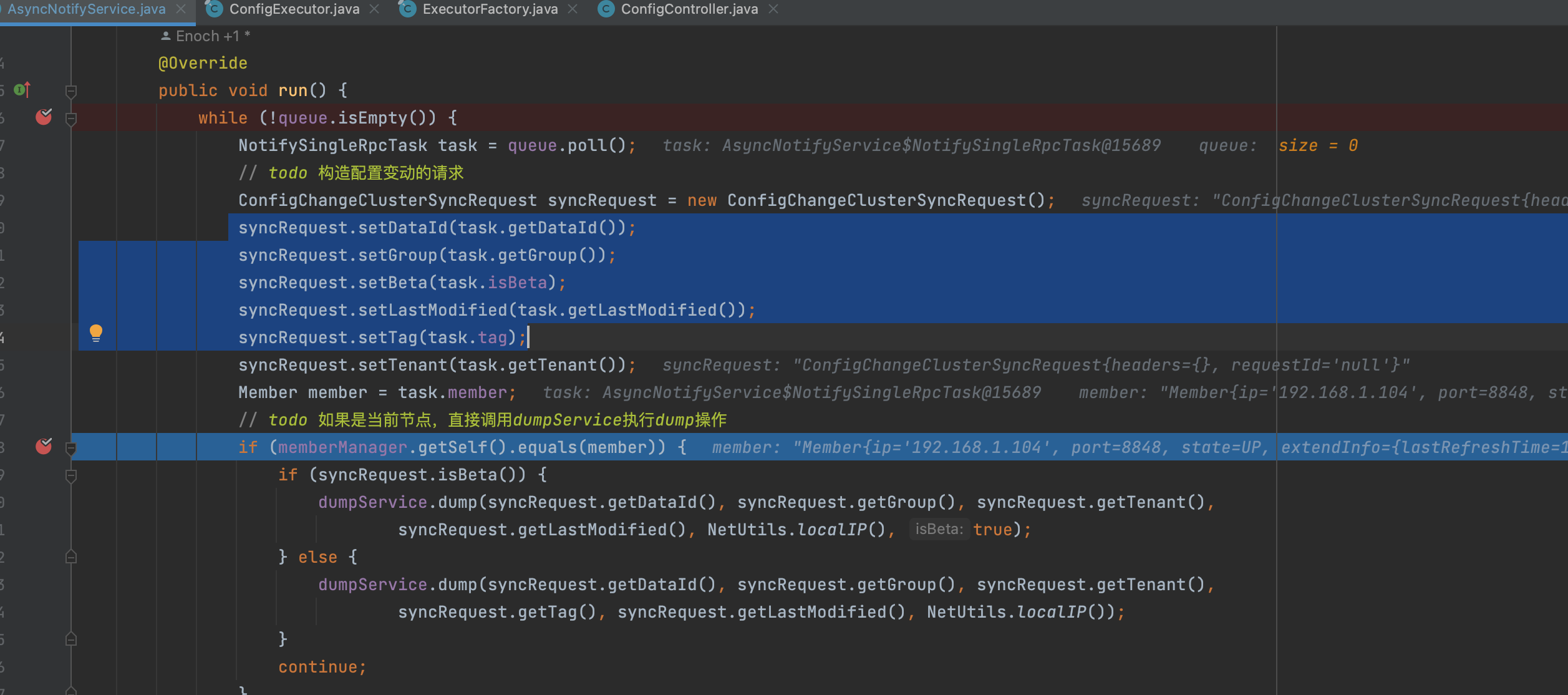
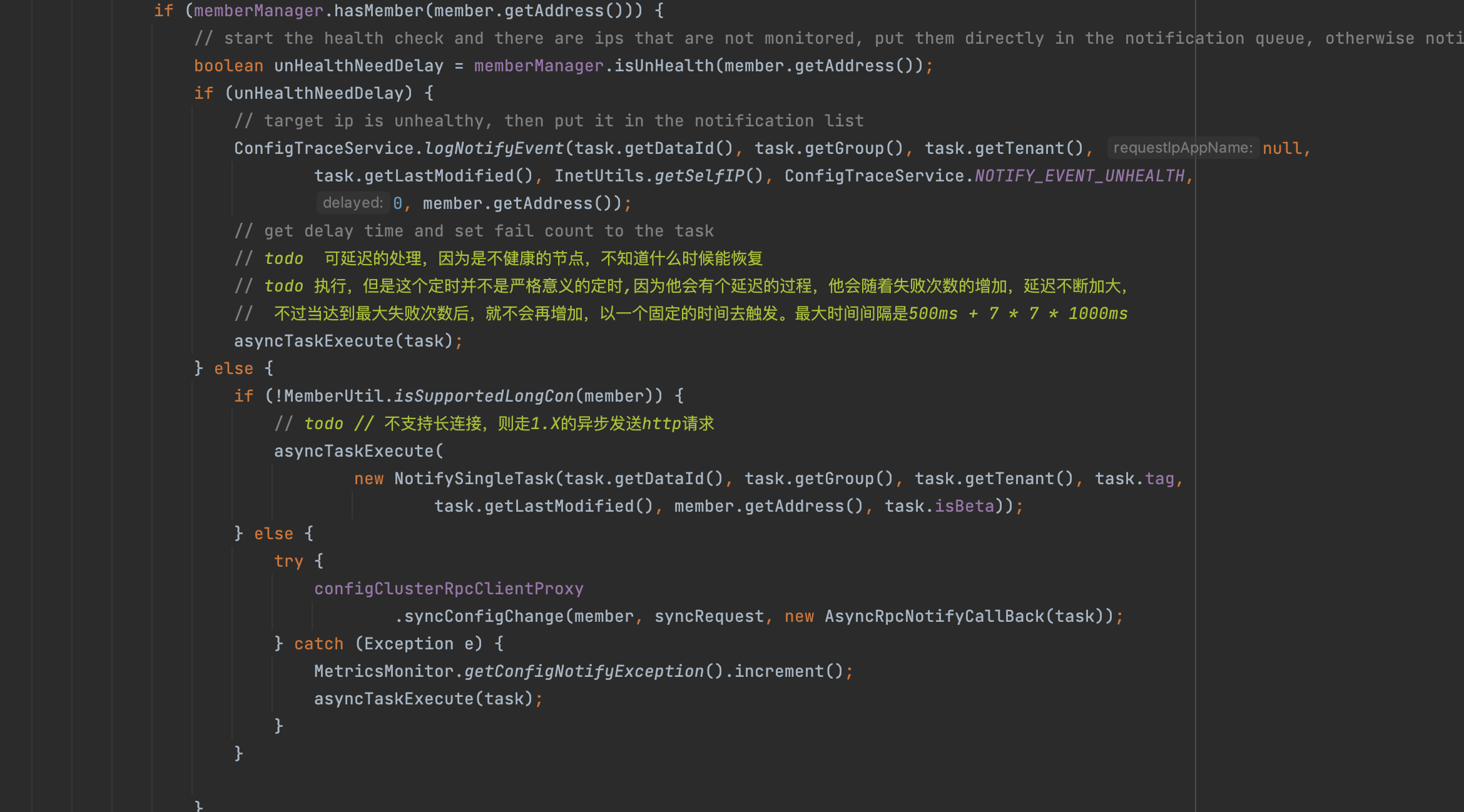
这里主要做了几件事:
- 从queue中获取通知任务,如果任务目标是当前节点,就直接调用dumpService.dump
- 如果是其他服务节点的话,判断是否支持长链接,如果支持就发送rpc请求,如果不支持就发送http请求
DumpService.dump

比较简单,将task放到TaskManager中,然后TaskManager异步执行
TaskManager
首先DumpService里面有一个TaskManager,这个类是继承NacosDelayTaskExecuteEngine�,这个类之前是详细分析过的,就是延迟执行的,核心逻辑就是有一个线程不断的从一个map中获取任务,
如果获取到任务,就看这个taskKey有没有对应的处理器,如果没有设置,那就找一个默认的,
刚好DumpService为TaskManager设置了一个默认的Processor,位置在DumpService的构造方法上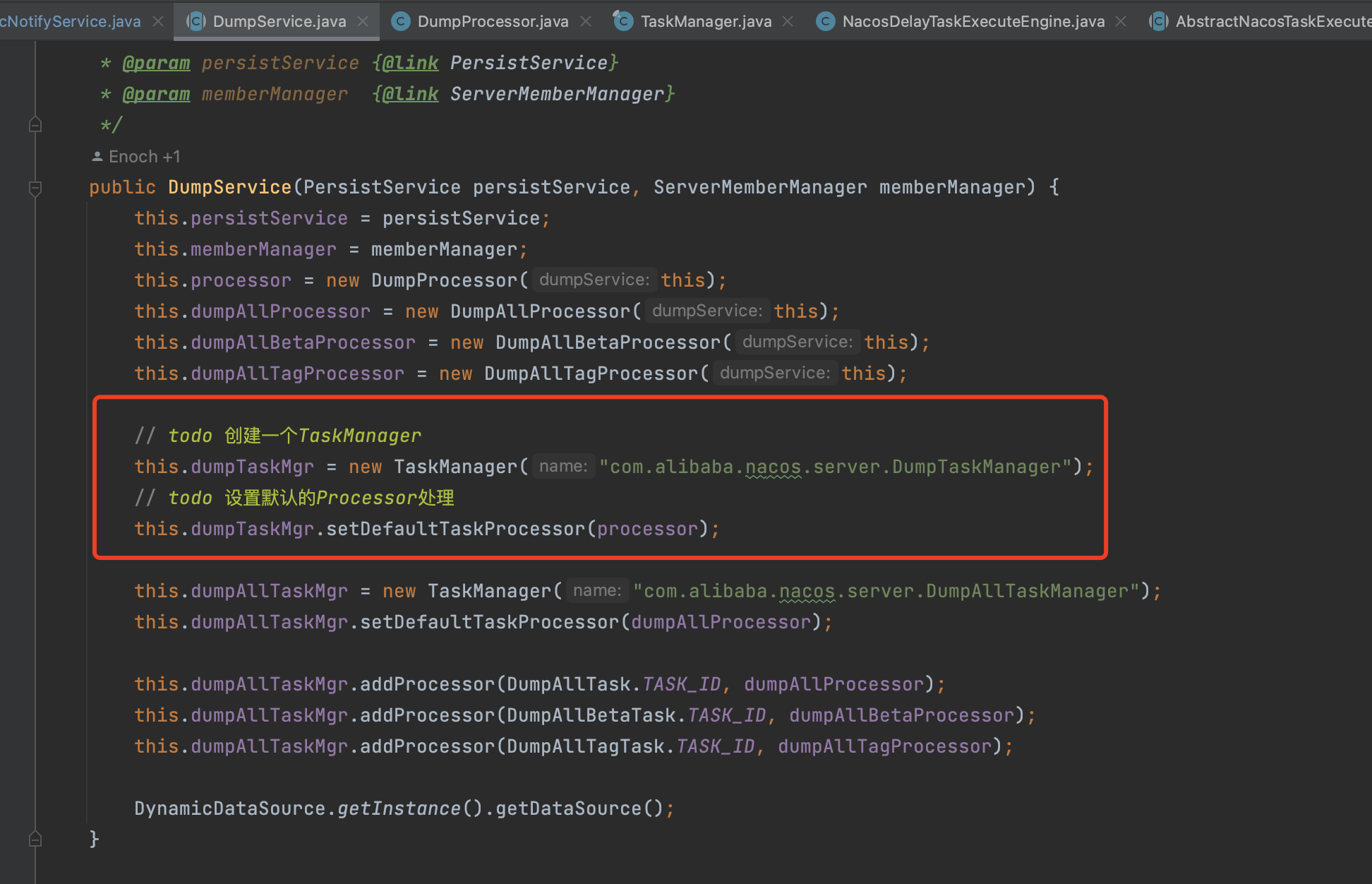
也就说说TaskManager.processTasks -> NacosDelayTaskExecuteEngine.processTasks ->DumpProcessor�.process方法
DumpProcessor.process
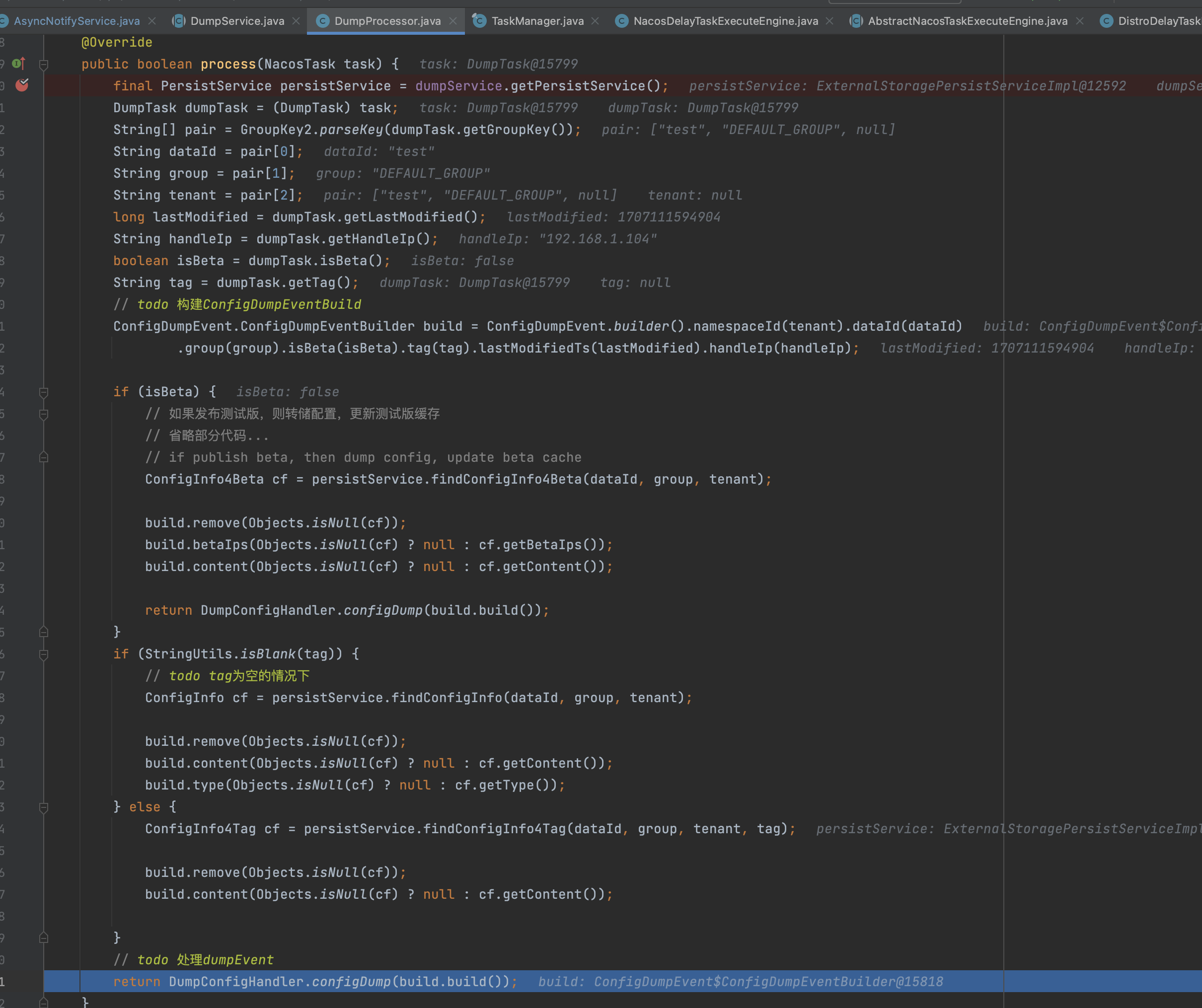
会调用到DumpConfigHandler
DumpConfigHandler.configDump
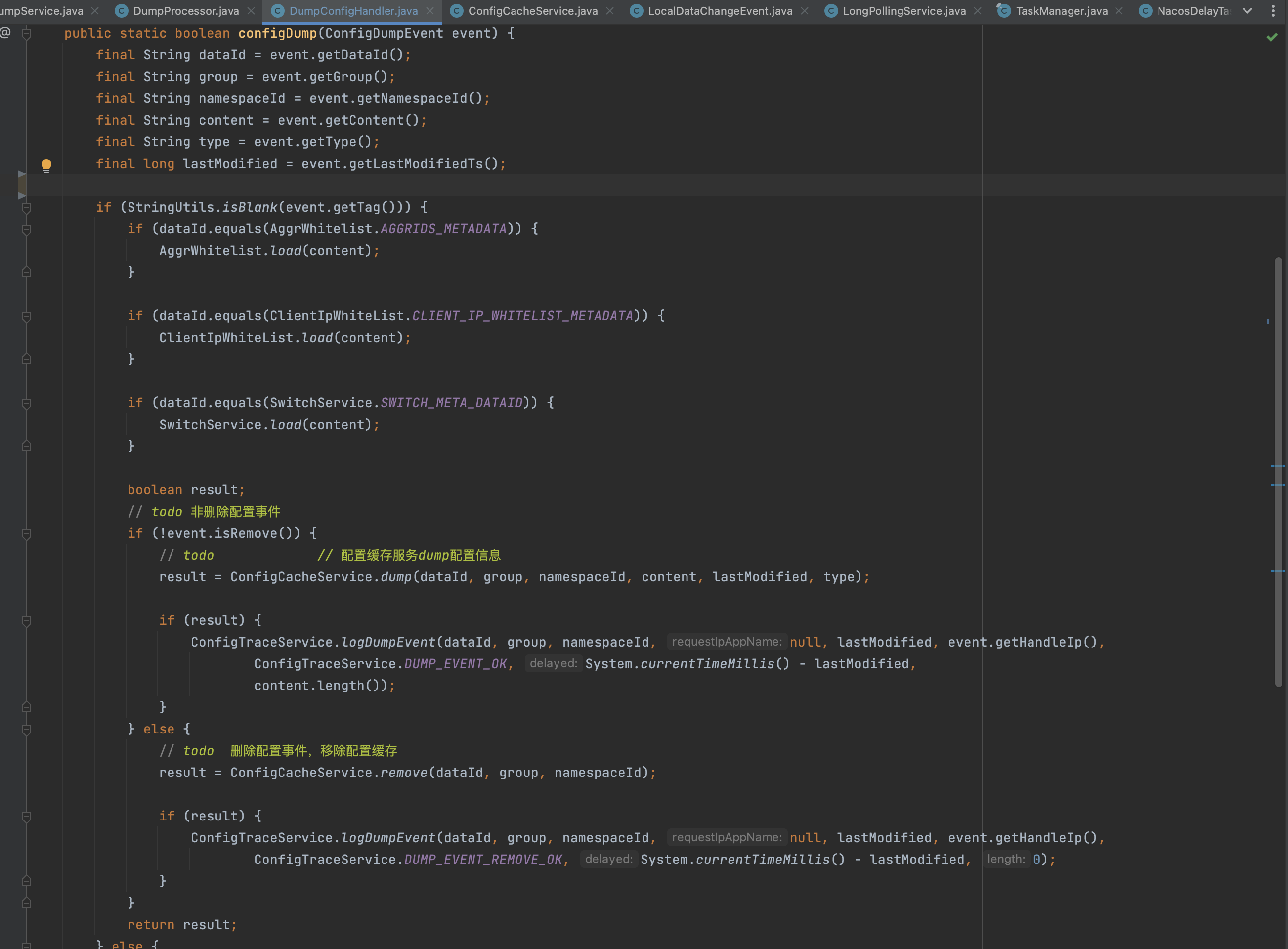
最终又调用到ConfigCacheService.dump
ConfigCacheService.dump
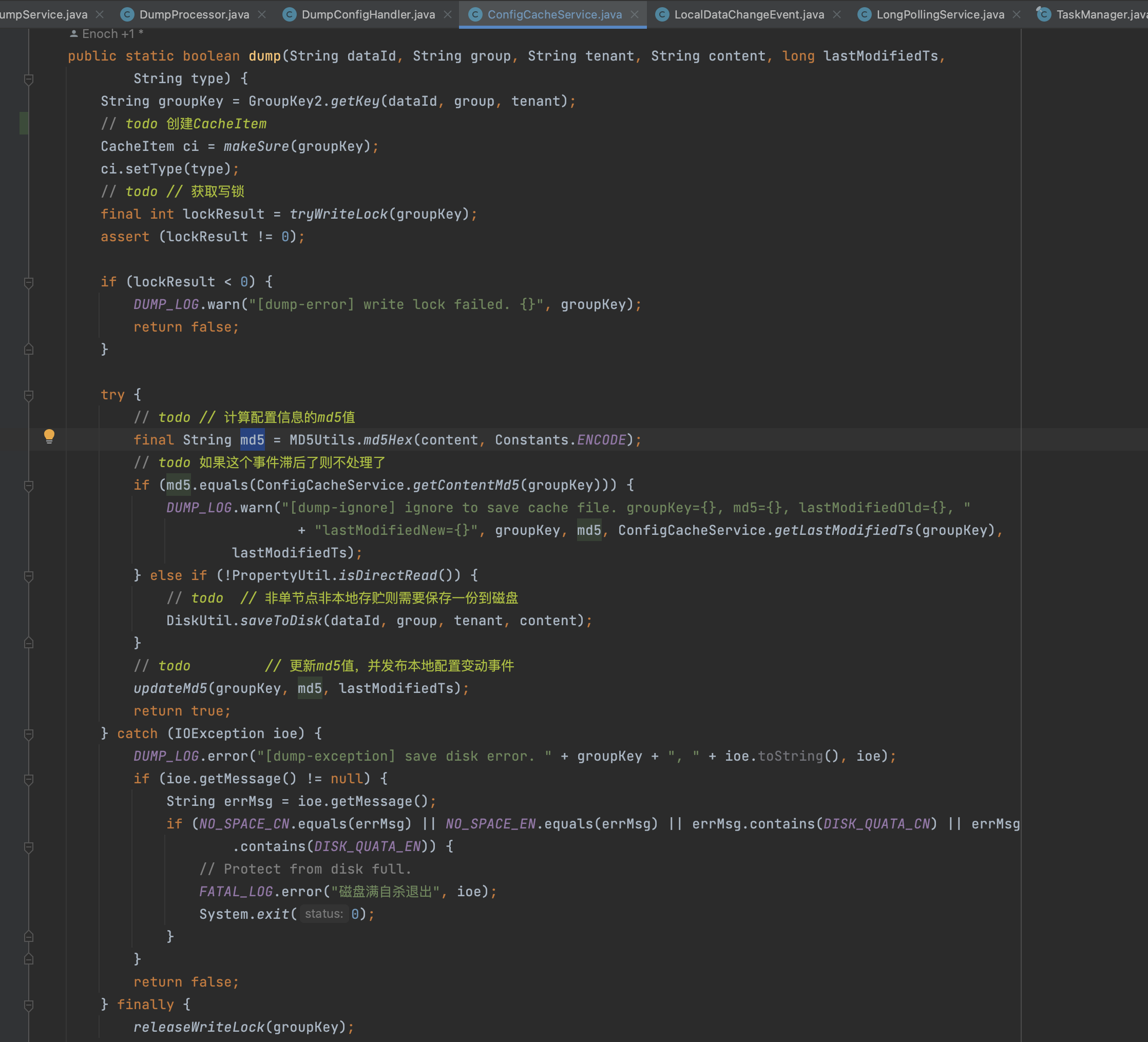
- 获取写锁
- 创建CacheItem
- 非单点 非数据库存储,需要保存到磁盘
- updateMD5:发送本地配置变更事件, 这个事件意义非凡,得好好看看

这里比较了一下md5值,如果不一样,就发送LocalDataChangeEvent事件,我们来看看这个事件又是谁处理的?PpcConfigChangeNotifier.onEvent(LocalDataChangeEvent)
RpcConfigChangeNotifier.onEvent
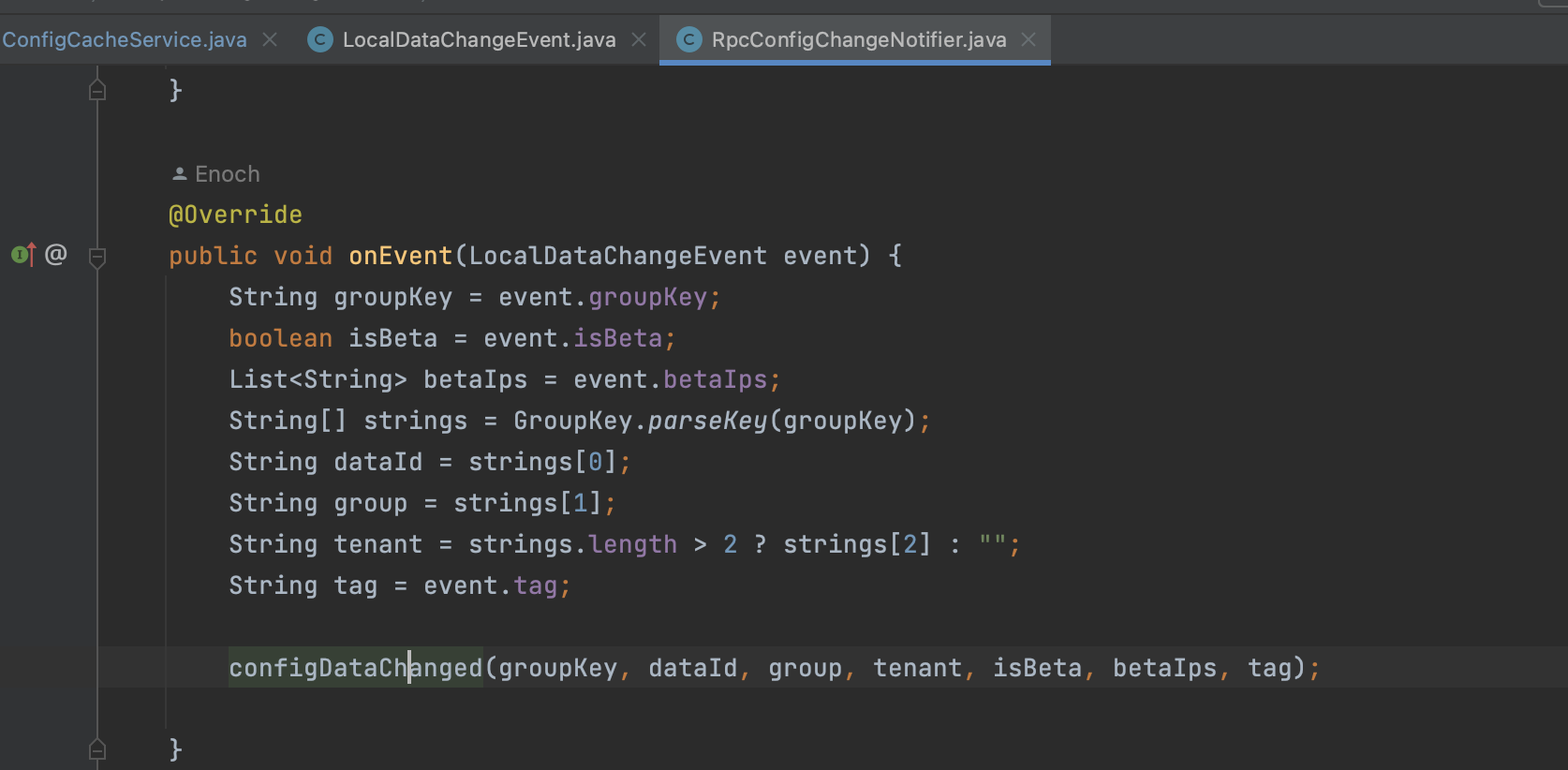
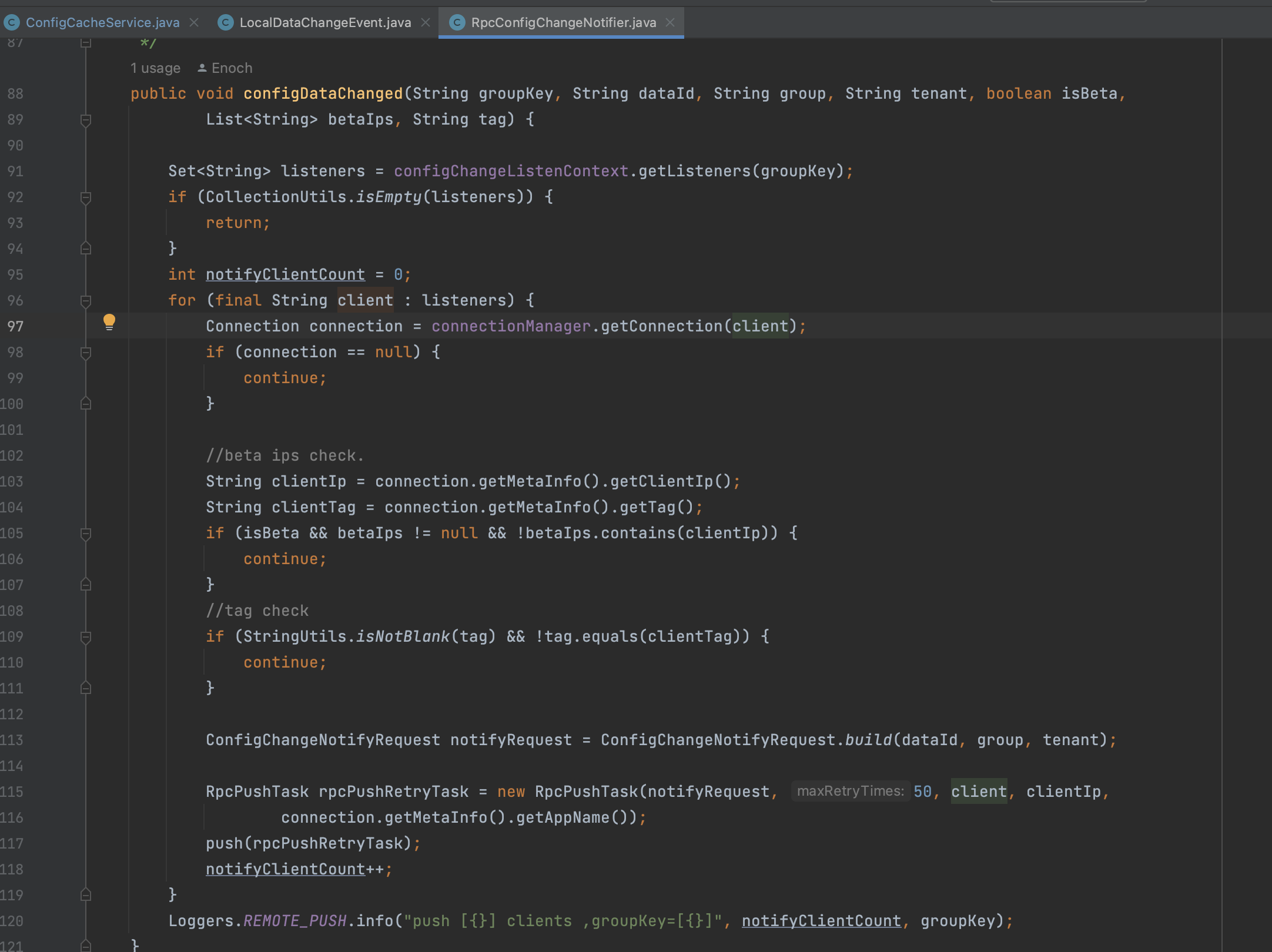
这里的大致逻辑就是:
- 判断groupKey对应有没有监听,也就是需不需要回调,如果有,会向客户端发送消息
- 通过clientId拿到客户端连接,然后就是往客户端发送Rpc ConfigChangeNofifyChangeRequest

之前我们在客户端源码里面讲过,在ensureRpcClient =>initRpcClientHandler里面会注册一个客户端处理服务端->客户端的handler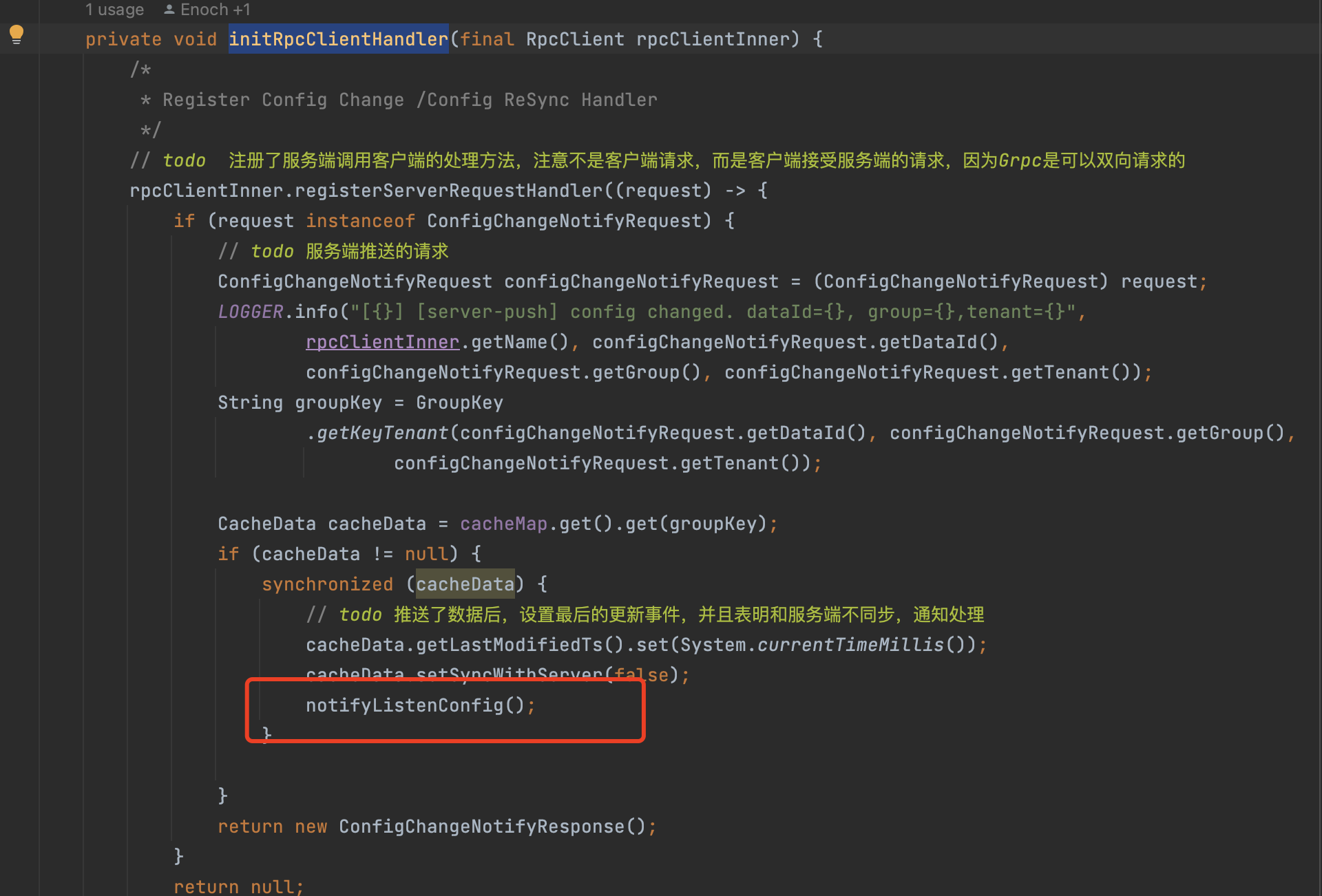
当客户端接受到notifyListenConfig,会往队列丢一个信号,客户端会马上执行,从服务端拉取最新的配置
�
�
ConfigClusterRpcClientProxy�.syncConfigChange
上面从3.4到3.8都是讲了当配置更新完毕,本机如何处理,那如果是其他Server或者客户端又该怎么处理那?
入口就是这个
也是是RpcClient发送请求
通过搜索ConfigChangeClusterSyncRequest�这个请求 找到具体的处理类是ConfigChangeClusterSyncRequestHandler�
ConfigChangeClusterSyncRequestHandler.handle
其他server通过这个handler.handle方法最终也是调用dumpService方法